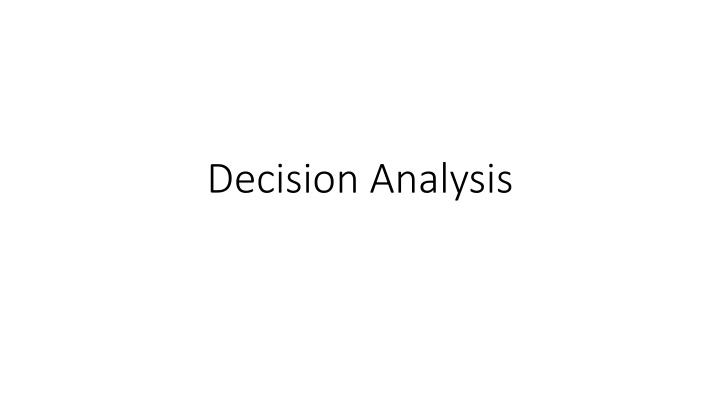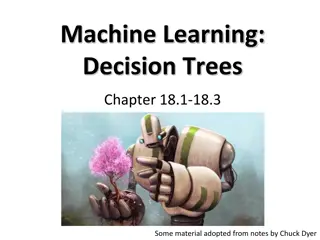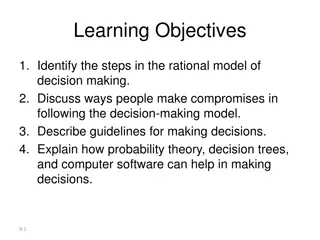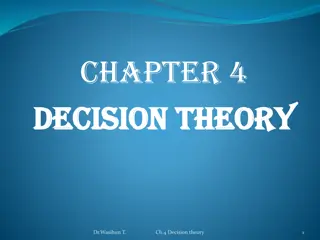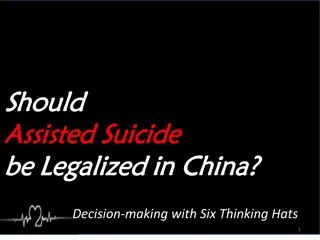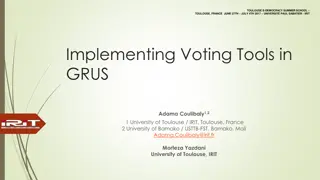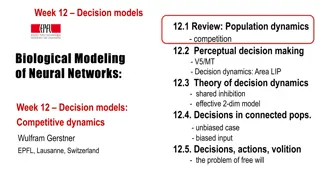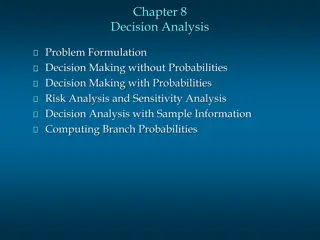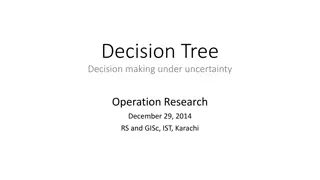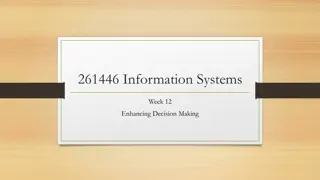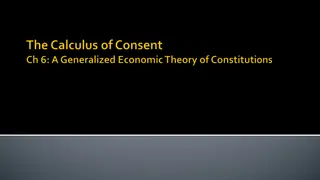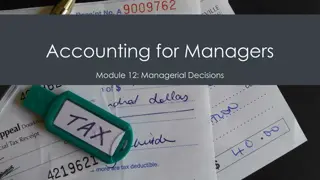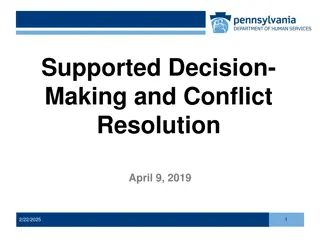Decision Analysis
Everyone faces various decisions in life, from career choices to investments. Decision analysis, also known as decision theory, provides methods for making wise choices amid uncertainty. This formal framework assists in selecting optimal strategies by evaluating alternative plans of action. The decision-making process involves steps like identifying possible outcomes, determining courses of action, and analyzing pay-offs. By choosing from available alternatives based on specific criteria, decision-makers navigate complex decision environments to reach optimal outcomes.
Download Presentation

Please find below an Image/Link to download the presentation.
The content on the website is provided AS IS for your information and personal use only. It may not be sold, licensed, or shared on other websites without obtaining consent from the author.If you encounter any issues during the download, it is possible that the publisher has removed the file from their server.
You are allowed to download the files provided on this website for personal or commercial use, subject to the condition that they are used lawfully. All files are the property of their respective owners.
The content on the website is provided AS IS for your information and personal use only. It may not be sold, licensed, or shared on other websites without obtaining consent from the author.
E N D
Presentation Transcript
Decision Analysis Introduction: Everyone of us has to make some kinds of decisions throughout life. What profession to choose, whom to marry, what to produce, how to produce, where and how much to invest. Some of the decisions are really difficulty to make because of the complexity of the decision situation. This is specially true in case of several business and Industrial problems which are becoming more and more complex. The decision making in business is not an easy task. Sometimes the decisions may be based on cost and profit calculations and at other times they may rest on relative competitiveness.
We need a decision theory which may be defined as a body of methods helpful to decision makers to select wisely one course of action (strategy) from amongst the alternative plans of action. Decision theory is concerned with how to assist people (or organization) in making decisions. The Decision theory is also called as the Decision Analysis. It provides a formal analytic framework for decision making under conditions of uncertain. It is used to determine the optimal strategies where a decision maker is face with several decision alternatives and an uncertain, or risky, pattern of future events.
Process of Decision making analysis The Decision making process, thus, involves the following steps: Identification of the various possible outcomes,called states of nature or events, Eis , for the decision problem. Identifications of the courses of action Ajs or the strategies that are available to the decision maker.The decision maker has control over choice of these. Determination of the pay-off function which describes the consequences resulting from the different combinations of acts ad events.The pay-off may be designated as Vjs the pay-off resulting from ith event and jth strategy.
Choosing from among the various alternatives on the basis of some criterion. The various pay-off elements may be summarized in the form of a pay-off table as below: In this table n states of nature(outcomes) are represented by E1,E2 --- ---En and m courses of action by A1,A2 -----Am
States of Decision alternatives (courses of action) nature (out comes) A1 A2 A3 Am E1 --- a11 a12 a13 a1m E2 --- a21 a22 a23 a2 m E3 --- a31 a32 a33 a3m . . . . . . . . . . . . . . . En --- an1 an2 an3 anm
Decision making environment or Decision Alternatives Decision analysis is used to determine optimum strategies where a decision maker is faced with several decision alternatives. we may come across several decision making situations. A) DECISION UNDER CERTAINTY: Deterministic pay-offs are the simplest possible pay-offs. Deterministic is related to deterministic situations. STEPS : a) Determine the alternative course of action. b) Calculate the pay-offs, one for each course of action. c) Select the alternative with the largest profit or smallest cost either by the method of complete enumeration or with the aid of appropriate mathematical models. Examples: Linear Programming, Transportation, Assignment etc.
B).DECISION UNDER UNCERTAINTY : Under conditions of uncertainty, only pay-off are known and nothing is known about the likelihood of each state of nature. Consequently, there is no single best criterion for selecting a strategy to deal with such a situation. But there are different criteria available for selecting a strategy. 1. Maximin (or Minimax) decision rule. 2. Maximax ( or Minimin) decision rule. 3. Savage decision rule. 4. Hurwicz decision rule. 5. Laplace decision rule.
Maximax or Minimin Criterion This is also known as criterion of optimism under this rule the decision maker is quite Optimistic (optimistic criterion). He assumes that the situation will all ways be to his advantages. He, therefore selects the strategy which yields him the best possible pay-off or the best of the bests. Under this rule the decision maker searches for the best possible pay-off for each alternative. The Maximax criterion consists of the following steps: Step 1: Determine the maximum possible pay-off for each possible. Step 2: Select that alternative which corresponds to the maximum of the above maximum pay offs.
DECISION MAKING UNDER UNCERTAINTY Criterion of Optimism . Criterion of Pessimism. Criterion of Regret. Equal Probability Criterion. Problem on the above Criterions : The management of X,Y,Z company is considering the use of a newly discovered Chemical which, when added to detergents, will make the washing set, thus eliminating the necessity of adding softners .The management is considering at present time, these three alternative strategies,
S1= Add the Chemical to the currently marketed DETER and sell it under label NEW IMPROVED DETER . S2= Introduce a brand new detergent under the name of SUPER SOFT S3= Develop a new product and enter the softner market under the name EXTRA WASH . The Management has decided for the time being that only one of the three strategies is economically feasible (under given market conditions ). The marketing research department is requested to develop a conditional pay-off matrix for this problem .After conducting sufficient research, based on personal interviews and anticipating the possible reaction of the competitors, the marketing research department submits the pay-off matrix given below. Select the optimal strategy.
